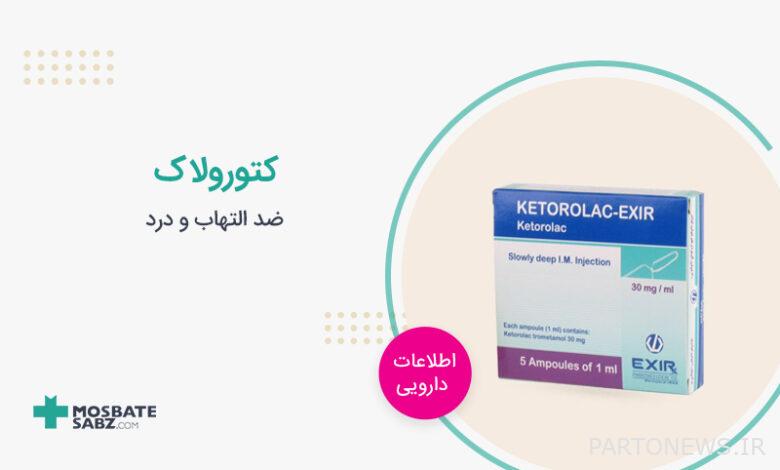What is Ketorolac?

Ketorolac is a nonsteroidal anti-inflammatory drug (NSAID) used for the short-term treatment of moderate to severe pain. This drug helps relieve pain and inflammation by reducing the production of inflammatory chemicals in the body. Ketorolac is available in various forms including tablets, capsules, ampoules and eye drops. Oral forms of ketorolac are usually used for pain in different parts of the body, while injectable forms of the drug are usually used for severe pain or pain from surgery. However, the contraindications and precautions of this drug are very wide, and its use requires a prescription and a doctor’s approval.
What we read in this article
Pharmaceutical forms of ketorolac
Ketorolac dosage forms include 10 mg tablets, 15 mg/mL and 30 mg/mL injectable solutions, 15 mg/mL, 30 mg/mL, and 60 mg/2 mg prefilled syringes. It is liter. Also, the drugs of its group are diclofenac, diflunisal, etodolac, fenoprofen, flurbiprofen, ibuprofen, indomethacin, ketoprofen, meclofenamic acid, mefenamic acid, meloxicam, nabumeton, etc.
- The biggest changes that will happen in WhatsApp this yearFebruary 3, 2024
- Applications for locating family and friends on AndroidFebruary 2, 2024
Ketorolac uses
Ketorolac is used for the short-term treatment of moderate to severe pain in adults. This drug is usually used before or after medical procedures and after surgery. This medication will help reduce your pain so you can recover more easily and return to your normal daily activities. It is also a nonsteroidal anti-inflammatory drug (NSAID) that works by blocking the production of certain natural substances in your body that cause inflammation. This effect helps to reduce swelling, pain or fever. Ketorolac should not be used for mild or long-term painful conditions (such as arthritis).
Pharmacological effects and mechanism of action of ketorolac drug
This drug inhibits the synthesis of prostaglandins in body tissues by inhibiting at least 2 cyclooxygenase COX isozymes, COX-1 and COX-2. It may also inhibit chemotaxis and alter lymphocyte activity, reduce proinflammatory cytokine activity, and inhibit neutrophil accumulation. These effects may contribute to anti-inflammatory activity. The maximum plasma concentration varies depending on the dose and route, and excretion occurs through urine (91%) and feces (6%).
Ketorolac dose
Take this medication by mouth as directed by your doctor, usually every 4 to 6 hours with a full glass of water (8 ounces or 240 mL). Do not lie down for at least 10 minutes after taking this medicine. If stomach upset occurs while taking this medication, take it with food, milk, or an antacid. Dosage is based on your medical condition and your response to treatment. To reduce the risk of stomach bleeding and other side effects, take this medicine with the lowest effective dose and for the shortest possible time.
Dosage of ketorolac in adults
- This medication is used for the short-term (≤5 days) management of moderately severe acute pain that requires opioid-level pain relief.
- For oral use (tablets), 20 mg once after intramuscular injection or intravenous injection treatment, then 10 mg every 4-6 hours is prescribed. The total consumption for this process should not exceed 40 mg.
- For intravenous (IV) administration, 60 mg is prescribed as a single dose or 30 mg every 6 hours, with a total dose not to exceed 120 mg per day.
- For intramuscular (IM) administration, use 60 mg as a single dose or 30 mg every 6 hours. Also, the total amount of this process should not exceed 120 mg per day.
- Always start treatment with this drug (ketorolac) with its injectable form, if necessary, use oral administration only as a follow-up dose of intravenous (IV) and intramuscular (IM) injections.
- The duration of use and treatment of this drug should be 5 days, taking a higher dose than the prescription does not provide better effectiveness, but increases the risk of serious side effects. Also consider reducing the daily dose in patients over 65 years old or less than 50 kg and with relatively high serum creatinine.
Time to use Ketorolac in children
- For the treatment of relatively severe acute pain in children aged 2 to 16 years, 5 mg/kg should be used as intramuscular or intravenous injection. Also, the total consumption of this process should not exceed 15 mg per day.
- In people over 16 years of age or less than 50 kg, the intravenous (IV) dose is 15 mg as a single dose or 15 mg every 6 hours, the intramuscular (IM) dose is 30 mg as a single dose or 15 mg every 6 hours and a single oral (PO) dose of 10 mg should be used after intravenous (IV) and intramuscular (IM) treatment.
- In people over 16 years of age and weighing more than 50 kg, the intravenous dose (IV) is 30 mg as a single dose or 30 mg in 6 hours, the total daily intake should not exceed 120 mg per day.
- For intramuscular (IM) administration, use 60 mg as a single dose or 30 mg every 6 hours, with a total dose not to exceed 120 mg.
- For oral (PO) administration, 20 mg once daily is used after intravenous (IV) and intramuscular (IM) treatment.
Precautions
Before taking ketorolac, tell your doctor if you are taking pentoxifylline (Pentoxyl) or probenecid (Probalan, in Col-Probenecid). If you are taking one or more of these medications, your doctor will likely prescribe similar medications. Also, if you have special medical records, including heart problems, digestive system disorders (stomach ulcer, esophageal ulcer, heartburn), respiratory disorders, severe liver or kidney disorder, specific lung disease, etc., talk to your doctor about the risks of using this medicine. consult.
- with caution in postoperative conditions, tonsillectomy in children (may interfere with hemostasis), gastric perforation, liver or kidney failure, history of liver or kidney disease, concomitant anticoagulant therapy, hypertension (may cause the onset new blood pressure or worsening blood pressure) and… used.
- Oral drug therapy should only be used as a continuation of initial parenteral therapy.
- Long-term administration of NSAIDs may lead to renal papillary necrosis and other kidney damage. Elderly people are at greater risk for this drug. People with weak kidney function, hypovolemia, heart failure, liver dysfunction or salt depletion, diuretics, angiotensin-converting enzyme (ACE) inhibitors or angiotensin receptor blockers, etc., should use this medicine with caution.
- Ketorolac may cause drowsiness, blurred vision and dizziness in some patients. In this situation, avoid doing things that require high alertness.
- This drug may increase the risk of hyperkalemia, especially in renal disease, diabetic patients, the elderly, and when used concurrently with other drugs capable of causing hyperkalemia.
- Do not use in patients with asthma sensitive to aspirin (severe bronchospasm may occur).
- Regarding the risk of heart failure (HF), NSAIDs have the potential to provoke HF by inhibiting prostaglandins, leading to sodium and water retention, increased systemic vascular resistance, and decreased response to diuretics. NSAIDs should be avoided or discontinued if possible.
Ketorolac contraindications
- The duration of drug treatment is only 5 days
- Demonstrated sensitivity to ketorolac or allergic manifestations to aspirin or other NSAIDs. Appropriate countermeasures should be available during the first injection of ketorolac.
- Major surgery: Contraindicated for prophylactic analgesia. It is contraindicated for the treatment of postoperative pain in CABG surgery.
- OB/GYN: Contraindicated during labor as it may adversely affect fetal circulation and inhibit uterine contractions. Contraindicated in breastfeeding women due to possible adverse effects of prostaglandin inhibitor drugs on infants.
- Kidney: Contraindicated with advanced kidney failure and in patients who are at risk of kidney failure due to volume reduction.
- GI: Contraindicated with previous or current active peptic ulcer disease, previous or current gastrointestinal bleeding.
- Bleeding risk: Contraindicated due to inhibition of platelet function, with suspected or confirmed cerebrovascular bleeding, hemorrhagic diathesis, incomplete hemostasis and high risk of bleeding.
- Use with other NSAIDs: Contraindicated in patients currently receiving aspirin or other NSAIDs because of the cumulative risk of serious NSAID-related adverse events.
- It is prohibited for intraspinal or epidural administration due to the presence of alcohol.
Cardiovascular risk of Ketorolac
- Nonsteroidal anti-inflammatory drugs (NSAIDs) may increase the risk of serious cardiovascular thrombotic events, myocardial infarction (MI), and stroke, which can be fatal.
- The risk may increase with duration of use.
- Patients with existing cardiovascular disease or risk factors for such disease may be at increased risk.
- NSAIDs are contraindicated for postoperative pain during coronary artery bypass grafting (CABG).
- Patients treated with NSAIDs after a heart attack were more likely to die within the first year of a heart attack than patients who were not treated with NSAIDs after their first heart attack.
Ketorolac gastrointestinal risk
- NSAIDs increase the risk of serious gastrointestinal side effects, including bleeding, ulcers, and perforation of the stomach or intestines, which can be fatal.
- GI side effects may occur at any time during use and without warning symptoms. Elderly patients are at increased risk for serious GI events.
Ketorolac side effects
Stomach or intestinal problems, swelling of the face, feet, or legs, and a sudden decrease in the amount of urine may occur, especially in elderly patients who are usually more sensitive to the effects of ketorolac than adults. Also, if this drug causes stomach problems, older people are more at risk than younger people. Studies in elderly people have shown that ketorolac stays in the body longer than in young people. The doctor should prescribe the drug and its dosage according to the age of the patient and taking into account the risks of use.
- Headache and drowsiness
- Indigestion
- Gastrointestinal pain
- Nausea and diarrhea
- dizziness
- itching
- human
- Increased blood urea nitrogen
- constipation
- Purpura
- Increased serum creatinine
- high blood pressure

Ketorolac drug interactions
- Class X interactions (avoid): acemethacin, aminolevulinic acid (systemic), aspirin, dex ibuprofen, dex ketoprofen, fluctaphenine, ketorolac (nasal), masimorline, mifamortide, morniflumate, nonsteroidal anti-inflammatory drugs, omastaxin, plobiprofen, pentoxifylline, phenylbutazone, probenecid, talniflumate, tenoxicam, urokinase, zaltoprofen
- Reduction of the effects of drugs by ketorolac (systemic): potassium-sparing diuretics, prostaglandins (ophthalmic), salicylates, selective serotonin reuptake inhibitors, sincalide, thiazide and thiazide-like diuretics, angiotensin-converting enzyme inhibitors, angiotensin II receptor blockers, aspirin, beta-blockers , eplerenone, hydralazine, loop diuretics, masimorelin, mifamortide
- Increased effects of drugs by ketorolac (systemic): aspirin, bemiparin, bisphosphonate derivatives, cephalothin, collagenase (systemic), cyclosporine (systemic), dabigatran etexilate, deferasirox, deoxycholic acid, desmopressin, dex ibuprofen, digoxin, drospirenone, edoxaban, enoxaparin, Eplerenone, haloperidol, heparin, non-steroidal anti-inflammatory drugs, obinotozumab, omastaxin, pentoxifylline, porfimer, potassium-sparing diuretics, pralatrexate, quinolones, rivaroxaban, salicylates, tacrolimus (systemic), tenofovir products
- Increased effects of ketorolac (systemic) by drugs: cyclosporine (systemic), dasatinib, dexketoprofen, oil emulsions (based on fish oil), flavinac, fluctafenin, glucosamine, herbs (with antiplatelet or anticoagulant properties), ibrutinib, inotresin, naphthazone , omega-3 fatty acids, pleubiprofen, pentosan polysulfate sodium, phenylbutazone, probenecid, prostacyclin analogs, selective serotonin reuptake inhibitors, selumetinib, serotonin/norepinephrine reuptake inhibitors, sodium phosphate, talaniflumate, tenoxicam, thiazide and thiazide-like diuretics
Use of ketorolac during pregnancy and breastfeeding
Ketorolac drug is in group C in terms of the risks of use during pregnancy, that is, it can be used under the supervision and examination of a doctor. But according to some reports, the use of this drug during pregnancy may cause premature closure of the ductus arteriosus. Also, this drug is excreted in human milk, and in case of use by a nursing mother, the baby should refrain from consuming breast milk for a while.
Ketorolac storage conditions
Ketorolac should be stored at room temperature and away from light and moisture. Also, all chemical and herbal medicines should be kept out of the reach of children and animals.
The last word about Ketorolac
As described in this article from the Green Positive Online Pharmacy magazine, Ketorolac as a non-steroidal anti-inflammatory drug (NSAID) with various positive effects plays a very important role in the management of pain and inflammation. With its unique mechanism of action, this drug has been recognized as a powerful solution in improving the quality of life of patients suffering from various diseases, including chronic pain and joint inflammation. However, it should be noted that excessive consumption or without a doctor’s prescription will cause dangerous side effects in patients.
Site source: Medscape

